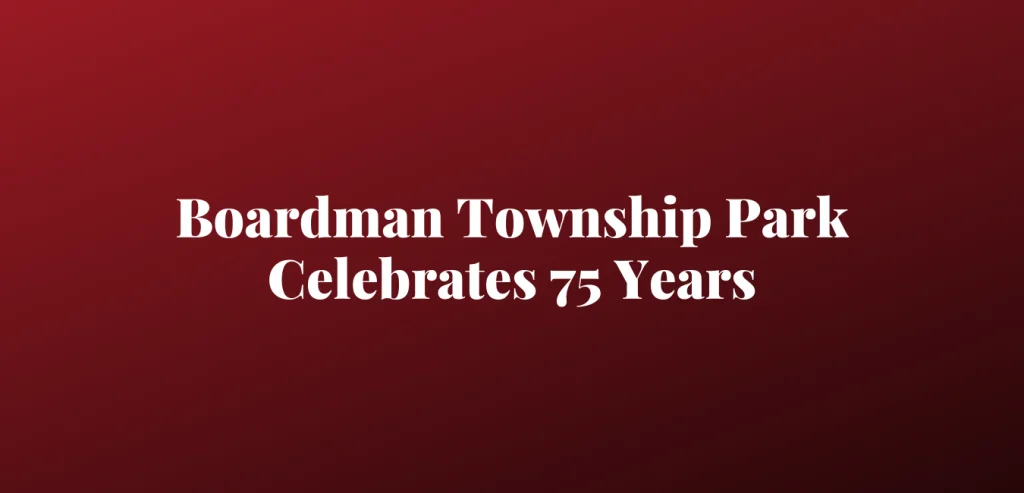The park was founded in Nov., 1947, when voters approved its formation by a 4-1 vote; followed by a 1-mil tax levy in 1948. The levy to this day, still provides the bulk of funding for the park district’s estimated $1.3 million annual budget.
Prior to its formation, the land on which the park sits was part of a 123-acre site of what the federal government called ‘surplus federal lands.’ Boardman Township purchased the property for $14,500 in 1946, and then turned around and sold the land to William F. Maag Jr. (WFMJ), who needed 51 acres to build a transmitter for his radio station. He then donated the rest of the property back to Boardman Township for the establishment of Boardman Park.
Named as the first commissioners to Boardman Park were Ralph P. Smith, Lewis Barger and Atty. Hugh Manchester., who along with architect H. Walter Damon and architect/engineer Chet Long. surveyed the property and began to develop plans for a park, including the main drive that still serves the park today.
A major addition to Boardman Park was completed in 1972, when St. James Church was moved from the center of the township to the front entrance of the park. The church, built in 1829, is among the oldest Episcopal church structures east of the Mississippi River.
In its early years, there were two pavilions, a winter ice skating rink and a baseball field, that along with all its woods, were the main features of the park. The ‘big event’ each year was the annual Memorial Day ceremonies that were held around the flag pole.
The park’s main ballfield, located near where the Maag Outdoor Arts Theater is today, served as home field for the Boardman Spartans baseball team. In the 1960s, famed NFL quarterback Joe Namath played baseball on that field as a member of the Beaver Falls High School diamond team.
E120: Tom McCabe, Mahoning County Republican Party Chair discusses politics & how “One Vote can make a Difference”
In 1949, Homer V. Holl Sr. was named as the first superintendent of Boardman Park. Chuck Wedekind served as superintendent from 1951 to 1956, when Ivor Jenkins took over the reigns. It was under Jenkins and park commissioners Phil Prosser, Frank Showalter and Frank Mastriana that St. James Church found its new home, gracing the entrance to Boardman Park and all who pass by on heavily-traveled Rt. 224.
Jenkins served until 1975 when John Holzbach took over the superintendent’s duties.
Under Holzbach, Boardman Park began to develop an historical village that today includes the Beardsley-Walter Diehm house, the Oswald Detch House and the Schiller-Chuey summer kitchen.
In addition, the gazebo that stands in the park today, was constructed, and the Georgeanna Parker Activity Center that houses the park district’s offices was constructed in 1976, the same year the annual Music in the Park concerts were begun.
Holzbach drew the ire of Township Trustees in the early 1990s, when concerns were aired about park funds being spent on a private collection of nature books. He was replaced by Daniel Slagle Jr., who has directed Boardman Park’s operations since 1992.
Under Slagle, the park district has prospered and greatly expanded its programming. Use of the park today draws more than 500,000 visitors annually, including at its biggest annual event, the Boardman Rotary Oktoberfest.
The Oktoberfest might never have been held, as when first proposed, park directors expressed concern that so many in people in the park at one time could damage its landscaping.
However, in 1976, Boardman Township held its Bicentennial Celebration at Boardman Park and the event drew upwards of 15,000 people—paving the way the next year for the first Oktoberfest.
When Slagle took over the duties of leading Boardman Park, he proposed a mission statement that was approved by the Board of Commissioners, providing guidance for the many improvements under his tenure.
That mission statement called for the park district “to provide a diversity of recreational and educational opportunities in an environment that lends itself to pleasant family experiences.”
For example, in 1993, Kids Town Playground was completed with the help of a large outpouring of community support, including hundreds of volunteers who built the playground.
In 1994, a hike and bike trail was completed, and in 1996, the Maag Outdoor Arts Theater was built. A year later, the Elton Beard family cabin and Hofmaster Pavilion was built.
Today, Boardman Park not only encompasses its original acreage, but also includes seven ‘open space’ lands scattered throughout Boardman Township, as well as the Southern Park Stables and the Clarence Smith Homestead (both located by Washington Blvd.).
E119: Bob Hagan, 33rd District Democratic Candidate-Discusses Solutions To Improve The District
In 1972, when Slagle began his career at Boardman Park, serving as commissioners were Frank Mastriana, George Economus and Phil Prosser. Others who served on the park board during Slagle’s tenure are Tom Masters, Janie Jenkins, Mark Luke, Jack Russell, Gwen Smith, Dr. Robert Johnson and Josh Zarlenga; as well as current commissioners Joyce Mistovich, Trent Cailor and Ken Goldsboro.
In remarks at last Saturday’s celebration, Joyce Mistovich, chairperson of the park’s board of commissioners noted “With support from the public and our visitors, Boardman Park has evolved into one of the most unique and popular recreation areas in the Mahoning Valley
“Boardman Park has grown tremendously over these 75 years [and] all of this has occurred as we have been operating on the equivalent of a one-mil levy for 74 years.”
This article is being republished with permission of the Boardman News.

